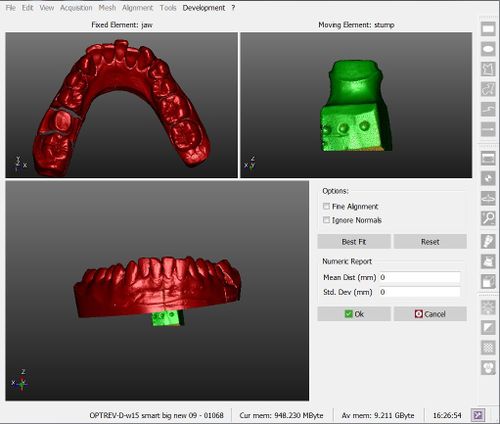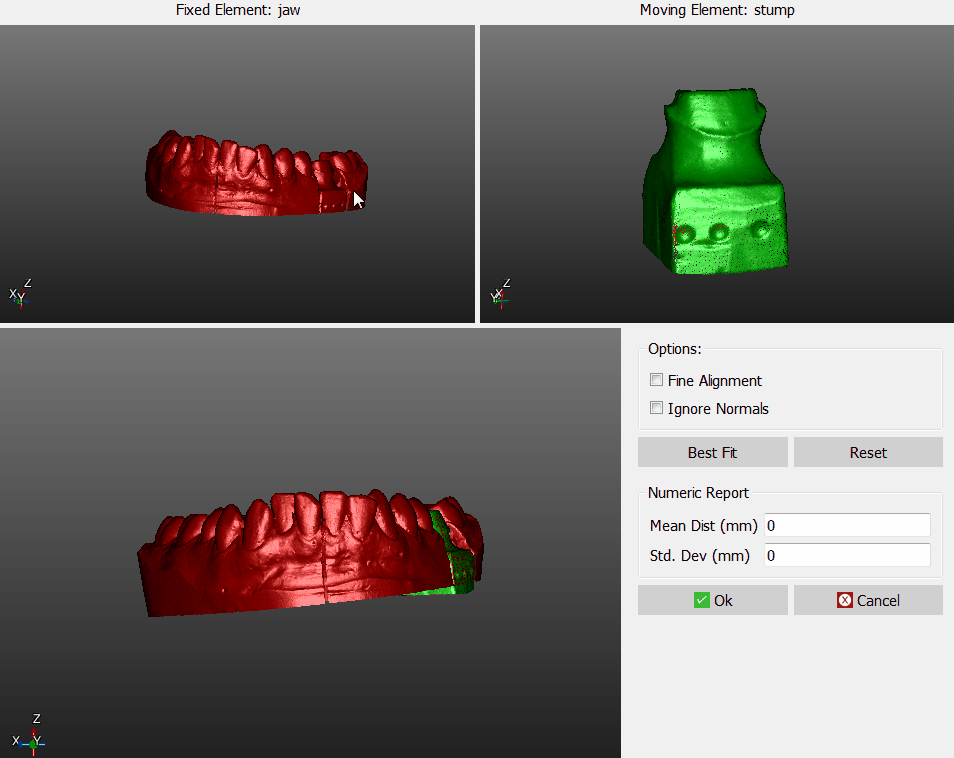Difference between revisions of "Man Align/de"
(Created page with "Die manuelle Ausrichtung wird jedes Mal gestartet, wenn die Software keine '''automatische Ausrichtung''' ausführen kann. Es ist außerdem möglich, diese Funktion durch län...") |
(Created page with "Das Bild zeigt das Interface der manuellen Ausrichtung:") |
||
| Line 28: | Line 28: | ||
== Interface == | == Interface == | ||
| − | + | Das Bild zeigt das Interface der manuellen Ausrichtung: | |
{{Screenshot|Dental_2_5_manualAlignment.jpg}} | {{Screenshot|Dental_2_5_manualAlignment.jpg}} | ||
Revision as of 19:13, 31 January 2016
Contents
Ausrichtung
Wenn mehrere Objekte gescannt werden, wird ihre relative Position am Anfang nicht aufgenommen. Um an den erfassten Daten korrekt zu arbeiten, muss diese in einem Bezugssystem aufgenommen werden.
Der Nutzer muss vor allem das Bild auswählen, das als Bezug für weitere Scanbilder gilt. Bei Strukturprojekten identifiziert die Software das Bezugselement jedes Elements automatisch.
Jedes Mal, wenn eine neue Information erfasst wird, ist es notwendig, neue Daten am Bezugsbild oder einem anderen, am Rest des Projekts schon ausgerichteten Scanbild, auszurichten.
Jedes gescannte Element hat ein bestimmtes Bezugsbild. Der Projektbaum zeigt diese Abhängigkeitsbeziehung: Jedes Tochterelement wird am entsprechenden Mutterelement ausgerichtet.
Automatische Ausrichtung
OpticalRevEng Dental kann Bilder automatisch ausrichten:
- Im Projektbaum das Element auswählen, das am Projekt auszurichten ist.
- Auf das Ausrichtungsicon in der Hauptwerkzeugleiste klicken.
Die Software identifiziert so das Bezugselement, analysiert das auszurichtende Scanbild mit dem jeweiligen Bezugselement und verschiebt das erste Element, um es an die Position des zweiten anzupassen.
Sollte es für die Software unmöglich sein, eine Ausrichtungsposition zu finden, wird die Funktion manuelle Ausrichtung gestartet.
´
Manuelle Ausrichtung
Die manuelle Ausrichtung wird jedes Mal gestartet, wenn die Software keine automatische Ausrichtung ausführen kann. Es ist außerdem möglich, diese Funktion durch längeres Drücken auf ![]() in der Hauptwerkzeugleiste zu aktivieren.
in der Hauptwerkzeugleiste zu aktivieren.
Interface
Das Bild zeigt das Interface der manuellen Ausrichtung:
There are 4 different areas in this screen:
- On the top left is displayed the reference object, which gives the reference position for all the project data
- On the top right is shown the moving object, that has to be moved from its current position and placed in the same reference system of all the other project data
- On the bottom are displayed both objects, so that the user can check the current position of the moving object
- On the bottom right some options and a Numeric Report are available
Procedure
To manually align the elements:
- Place both the reference object and the moving object in the same point of view, until the parts in common are visible
- Click on the same point on both the objects
- Check in the 3D view below, if the position is more or less correct (it's not necessary, at this stage, to find the perfect position)
- Click the Best Fit button on the right
If the two objects have enough points in common, the software will find the best alignment between them. Visually check the alignment on the bottom 3D View or by reading the values in the Numeric Report.
If the alignment is correct, click Ok to confirm the new position of the moving object.
Otherwise, click the Reset button and restart the alignment.
Options
There are two options available during the manual aligment:
- Fine Alignment : usually Best Fit moves the object up to 1mm closer to the reference. If the parts in common between the two objects are really small ,use Fine Aligment to move the object not more than 0.1mm closer to the reference
- Ignore Normals : allows the user to align the internal part of an object to the external part of another, and viceversa.




